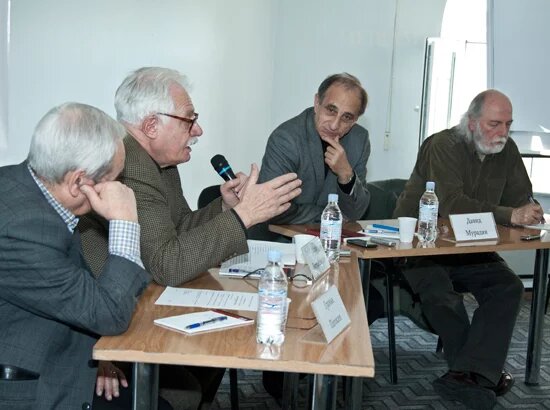
Main speakers:
Lado Vardosanidze – architect, expert on urban studies, Professor at the Technical University of Georgia;
Hrachya Poghosyan – architect, Deputy Chair of the Urban Planning Council of Yerevan Municipality;
Levon Abrahamyan – anthropologist, Corresponding Member of the National Academy of Sciences of Armenia.
Moderator: David Muradyan – author, film critic, Chair of the Armenian National Film Academy.
Opening the debate, moderator David Muradyan pointed out that the image of a city is not just about architecture, design or infrastructure, but also about the people who live in it, shape it and create its lifestyle; the software rather than the hardware.
Lado Vardosanidze was the first to speak. He began by agreeing with David Muradyan’s about the ‘software’ aspect of the City Image, adding that the modern concept of ‘urban development’ is about hardware and software seen together, as a whole. He then reminded the audience about the cultural ties between Yerevan and Tbilisi; in a brief historical overview, he looked at the way the two cities influenced each other. He went on to say that, with global cities such as Tokyo, New York and London playing such a significant role in political, economic and cultural life, the rivalry between cities in the modern world is somewhat bigger than between countries. In this context, special attention is paid to city brands such as slogans and imagery. Focusing on the modern image of Tbilisi, Mr. Vardosanidze spoke about the way in which government policy, in this case transparency is reflected in the city’s architecture, namely, in its numerous new buildings with glass facades.
Hrachya Poghosyan, the architect of modern as well as Soviet landmark buildings in Yerevan, was the second speaker. He emphasized the role that architecture (hardware) plays in forming people’s way of thinking (software). Since ancient times, rulers have been aware of this factor and used it to impose authority and ideology. Speaking of Yerevan, the Mr. Poghosyan reminded the participants that the modern image of Yerevan started developing at the beginning of the 20th century, i.e. under the Soviet rule, and gave credit to Alexander Tamanyan who was the creator of the first master plan of contemporary Yerevan. Mr. Poghosyan admitted that, unfortunately, after the collapse of the Soviet Union Yerevan started developing rather chaotically. The main issue with this is the loss of the tradition which crucial in giving city dwellers a sense of security, consistency and stability. The good news, in Mr. Poghosyan’s opinion, is that the current government is aware of the problem; hopefully the creation of Urban Planning Council of which Mr. Poghosyan is a member will help in improving this situation.
Third speaker, Levon Abrahamyan, spoke from an anthropological perspective, focusing on relations between architects and the authorities, who have been the architects’ main clients and thereby played the key role in creating the City Image. Applying the theoretical concept of ‘Culture Two’ (introduced by Zinovy Paperny and known in English as ‘Architecture in the Age of Stalin’) to Yerevan, he argued that the Armenian capital falls exactly into the totalitarian paradigm of urban planning. To illustrate his point, he mentioned that in Tamanyan’s original project, the Opera House was supposed to be topped with a gigantic statue of Lenin. Mr. Abrahamyan argued that the totalitarian tradition has flown over into modern Armenia, citing the recently built Northern Avenue in Yerevan as a vivid example.
The ensuing debate was focused on decision-making in the realm of urban planning, in a comparative perspective of Yerevan and Tbilisi. Mr. Abrahamyan’s vision of modern Yerevan as a ‘totalitarian city’ was questioned by many in the audience; some pointed out that although its aesthetic quality is widely disputed (as was the quality of many Soviet landmarks), the city’s dwellers, especially young people, use the Northern Avenue a lot for leisure and social life, which is what matters in the final analysis. Others insisted that continuity per se was of key value, and questioning Tamanyan’s oeuvre on the grounds that he served the Soviet authorities would mean throwing the baby out with the bathwater; it was agreed that an architect cannot choose his clients but can still try to do his best when designing buildings. The role of new democratic trends, as opposed to top-down decision-making, was discussed and assessed as also very often controversial, as in the examples when environmental activists in Tbilisi and Yerevan opposed the erection of new buildings even when these were planned as cultural centers, such as a theatre, and the trees intended for cutting were poorly integrated into the urban environment.
Summing up, David Muradyan pointed out that the two very different cities share many problems and trends, in terms of both hardware and software, and that cross-border opinion-sharing on the topic may cause the birth of new visions and ideas.